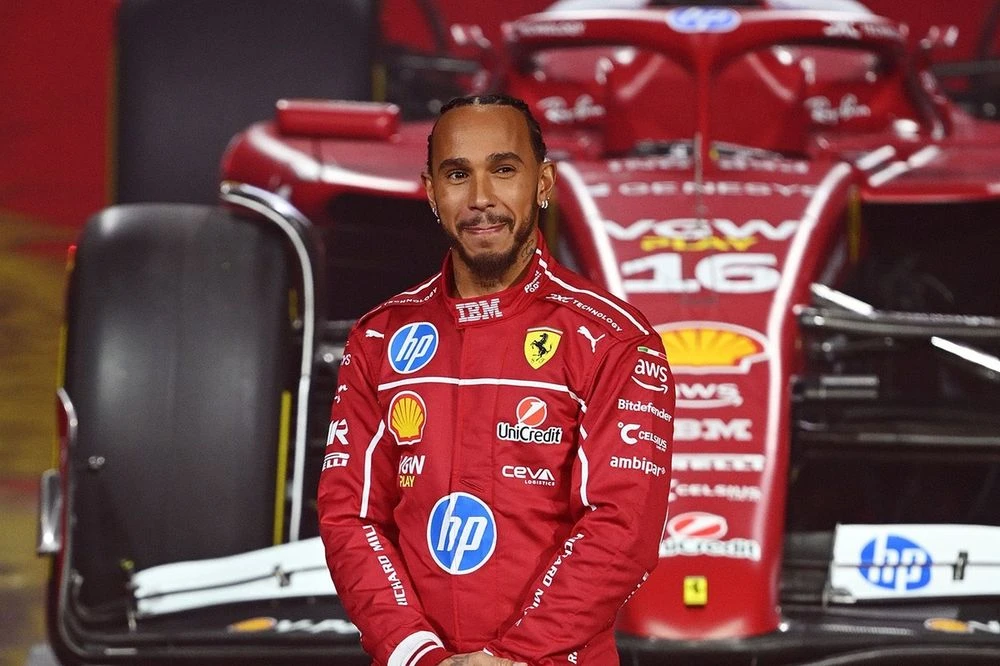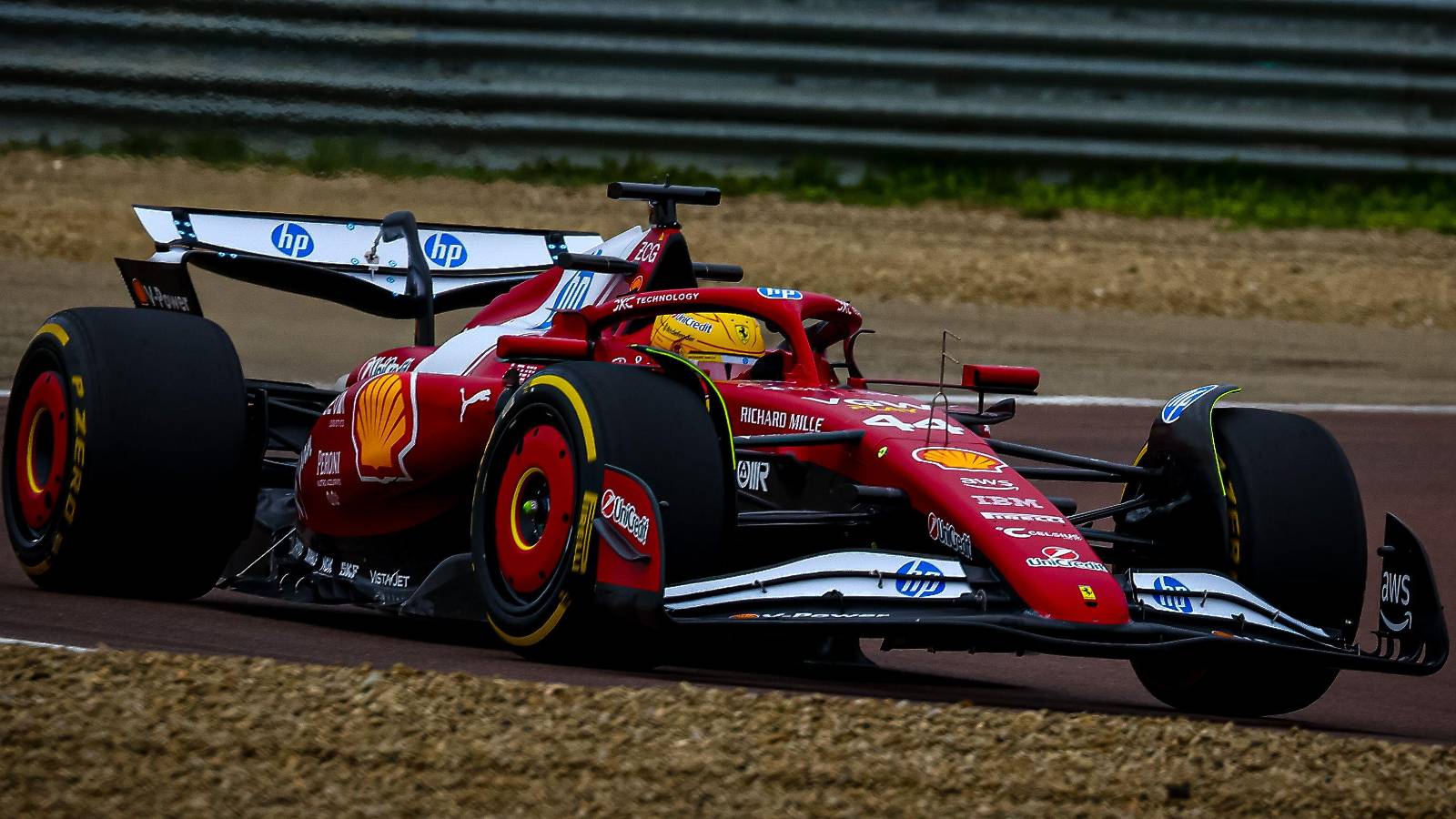After months of speculation, relentless development, and engineering scrutiny, the results of Lewis Hamilton’s new floor upgrade at Ferrari have finally been revealed. What is being reported out of Maranello is nothing short of monumental—a leap that is already being hailed as one of the biggest technological breakthroughs in recent Ferrari history.
Background: Ferrari’s Struggle and the Search for Solutions
The 2025 Formula 1 season began with high hopes for Ferrari, with seven-time world champion Lewis Hamilton joining the legendary Scuderia. However, the SF25 chassis did not deliver the magic many expected.
Instead, Hamilton and teammate Charles Leclerc found themselves frustrated with a car plagued by rear instability, unpredictable handling, and excessive tire wear—especially at high speeds. As Hamilton struggled to extract his trademark performance, the spotlight turned to Ferrari’s technical department for answers.
Months of private simulations and wind-tunnel research in Maranello pointed to a critical weakness: the car’s floor. In the ground-effect era of F1, the car’s underbody generates most of its downforce. A flawed floor design didn’t just hamper grip; it destabilized the car, limited aerodynamic development elsewhere, and left the team trailing rivals like Red Bull and McLaren.
The Game-Changing Upgrade: Redesigning the Floor
Recognizing the floor as the linchpin of their troubles, Ferrari opted for a bold, ground-up redesign rather than incremental tweaks. Engineers, using detailed computational fluid dynamics (CFD) and real-world data, opted for a radical overhaul of the floor geometry, underbody channels, and diffuser interplay.
The newly engineered floor featured reshaped Venturi tunnels designed to keep airflow stable and attached under the SF25, particularly during aggressive turns.
Old problem: Airflow would detach and stall mid-corner, leading to sudden rear-end instability.
New solution: With the new floor, airflow remains attached, the rear axle generates more consistent grip, and the car remains balanced whether approaching, apexing, or exiting fast corners.
Further, the integration with the gearbox casing and the redesign of the central keel have ensured improved stability under braking—a problem Hamilton raised numerous times in early-season debriefs. The result? The car now behaves predictably as speed drops, allowing for more confident late braking—Hamilton’s trademark.

Proving Grounds: Tests and Data
The new floor underwent extensive private tests at the Red Bull Ring, piloted first by Charles Leclerc and a Ferrari junior driver. Hamilton himself wasn’t behind the wheel for the initial test, but he was closely involved in engineering discussions and reviewing telemetry.
Test Results Highlight Major Shifts:
Stability: The SF25 with the new floor felt immediately more planted in high-speed corners.
Corner Entry and Exit: Drivers noted a newfound ability to trail brake and aggressively attack corner entries without fear of sudden oversteer.
Rear Tire Performance: Telemetry showed up to a 17% reduction in rear tire degradation—crucial for long stints and race strategy.
Lap Time: In back-to-back race simulations, the SF25’s new floor delivered average lap time gains ranging from 0.3 to 0.6 seconds per lap, depending on conditions.
Technical Triumph: Why This Upgrade Works
The standout factor is how the floor now manages airflow across all phases of a lap:
Ground Effect: The floor’s tunnels extract more ground effect downforce, sucking the car to the road.
Pressure Control: Redesigned tunnels and diffusers maintain high-pressure air where needed, eliminating the old unpredictability.
Cooling and Reliability: Unlike many high-downforce upgrades, the Ferrari upgrade preserves the car’s cooling efficiency and has caused no reliability issues in testing.
Critically, these technical improvements have made the SF25 easier to set up, with a wider operating window—a relief for engineers and drivers. For Hamilton, the car will now allow him to push at the limit, corner after corner, without second-guessing the rear-end behavior.
Psychological Impact
Beyond numbers and aero maps, Ferrari’s upgrade represents a psychological milestone. Both Hamilton and the team endured grueling weekends playing catch-up, with engineers working around the clock and drivers losing confidence. Now, garage morale has transformed: There’s visible optimism, engineers are more assured, and Hamilton himself is energized. For a driver of his caliber, confidence in machinery unlocks next-level performance—a critical factor in title campaigns.
What This Means for Hamilton and Ferrari
The new floor is just the first act in Ferrari’s ambitious drive toward the front of the grid. A complementary suspension package, targeting mechanical grip and further stabilizing the car over bumps and curbs, is set for debut at Silverstone. Together, Floor 2.0 and the new suspension may render the SF25 a “B-spec” machine, a fundamentally improved car ready to challenge for poles and wins.
Immediate consequences and expectations:
Qualifying: The SF25 can now be run closer to the track without bouncing or losing balance—key for maximizing downforce and grip, especially in qualifying.
Race Strategy: Reduced tire wear and improved stability open up new strategic avenues, including overcuts and late-race charges.
Hamilton’s Driving: The upgrade lets Hamilton drive aggressively, using his smooth yet forceful style to perfection.
Looking Ahead: The Path to Redemption
With recent upgrades, Ferrari has corrected the SF25’s biggest flaws. For Hamilton, that means shifting away from damage limitation and toward unleashing outright performance. As both upgrades come together, expect to see Hamilton recapture his relentless form—qualifying up front, battling for podiums, and playing a factor in race outcomes once again.
The Maranello squad, often beset by mid-season frustration, now finds itself carrying momentum, belief, and a car no longer fighting its drivers, but empowering them. With Hamilton’s confidence restored and the SF25’s weaknesses behind them, Ferrari’s tide may be turning—and so, perhaps, is the arc of the 2025 F1 season.





